Enhancing Fatigue Resistance in Asphalt Mixtures with a Novel Additive Derived from Recycled Polymeric Fibers from End-of-Life Tyres (ELTs)
Abstract
:1. Introduction
2. Materials and Methods
2.1. WTTF-Based Additive
2.2. Commercial Cellulose Additive
2.3. Asphalt Binder
2.4. Aggregates
3. Experimental Design
3.1. Asphalt Mix Design
3.2. Preparation of Asphalt Mix Samples
3.3. Testing Methods
3.4. Statistical Analysis
4. Analysis of the Results
4.1. Results of HMA Mixtures
4.2. Durability Results of the Pavement Structure of HMA Mixtures
4.3. Results of SMA Mixtures
4.4. Durability Results of the Pavement Structure of SMA Mixtures
5. Conclusions
- Fatigue laws showed that the use of the WTTF-based additive allowed for improving the resistance of HMA and SMA mixtures to fatigue damage. These mixtures indicated a higher capacity to withstand load cycles before reaching failure, with ε (106) values higher than those of the reference mixtures;
- The use of the WTTF-based additive in HMA and SMA mixtures indicated an improvement in the viscoelastic property of the mixture. As a result, these mixtures showed increased flexibility with a slower reduction in stiffness as load cycles were applied, which indicated a greater ability to dissipate energy during the cracking process;
- Regarding the stiffness modulus at 20 °C, the incorporation of the WTTF-based additive in the HMA mixture generates an increase in its stiffness modulus value compared to the reference mixture, which contributes to the pavement structure. In the case of the SMA mixture, the WTFF-based additive showed stiffness modulus values similar to those of the reference mixture;
- The durability evaluation showed that all mixtures with WTFF-based additive presented increases in durability compared to the reference mixtures, both at different pavement thicknesses and for both types of axle loads evaluated;
- ANOVA showed a significant effect of WTTF-based additive on the performance of the HMA and SMA asphalt mixtures versus the fatigue performance of mixtures in a pavement structure;
- This research demonstrates the potential of the WTTF-based additive to optimize the durability of asphalt mixtures. This additive, developed from a massive by-product of the tire-recycling industry, not only promotes sustainability but also reduces the need for virgin raw material in SMA mixtures.
6. Recommendations
Author Contributions
Funding
Institutional Review Board Statement
Data Availability Statement
Acknowledgments
Conflicts of Interest
References
- Martínez, J.D. An overview of the end-of-life tires status in some Latin American countries: Proposing pyrolysis for a circular economy. Renew. Sustain. Energy Rev. 2021, 144, 111032. [Google Scholar] [CrossRef]
- Xiao, Z.; Pramanik, A.; Basak, A.K.; Prakash, C.; Shankar, S. Material recovery and recycling of waste tyres—A review. Clean. Mater. 2022, 5, 100115. [Google Scholar] [CrossRef]
- Fiksel, J.; Bakshi, B.R.; Baral, A.; Guerra, E.; Dequervain, B. Comparative life cycle assessment of beneficial applications for scrap tires. Clean Technol. Environ. Policy 2011, 13, 19–35. [Google Scholar] [CrossRef]
- Bockstal, L.; Berchem, T.; Schmetz, Q.; Richel, A. Devulcanisation and reclaiming of tires and rubber by physical and chemical processes: A review. J. Clean. Prod. 2019, 236, 117574. [Google Scholar] [CrossRef]
- ETRMA European Tyre Industry Statistics, 2021 ed.; The European Tyre & Rubber Manufacturers’ Association: Bruxelles, Belgium, 2021.
- Sagar, M.; Nibedita, K.; Manohar, N.; Kumar, K.R.; Suchismita, S.; Pradnyesh, A.; Reddy, A.B.; Sadiku, E.R.; Gupta, U.N.; Lachit, P.; et al. A potential utilization of end-of-life tyres as recycled carbon black in EPDM rubber. Waste Manag. 2018, 74, 110–122. [Google Scholar] [CrossRef]
- Landi, D.; Vitali, S.; Germani, M. Environmental Analysis of Different End of Life Scenarios of Tires Textile Fibers. Procedia CIRP 2016, 48, 508–513. [Google Scholar] [CrossRef]
- Bocci, E.; Prosperi, E. Recycling of reclaimed fibers from end-of-life tires in hot mix asphalt. J. Traffic Transp. Eng. Engl. Ed. 2020, 7, 678–687. [Google Scholar] [CrossRef]
- Formela, K. Sustainable development of waste tires recycling technologies—Recent advances, challenges and future trends. Adv. Ind. Eng. Polym. Res. 2021, 4, 209–222. [Google Scholar] [CrossRef]
- Fazli, A.; Rodrigue, D. Recycling waste tires into ground tire rubber (Gtr)/rubber compounds: A review. J. Compos. Sci. 2020, 4, 103. [Google Scholar] [CrossRef]
- Landi, D.; Marconi, M.; Meo, I.; Germani, M. Reuse scenarios of tires textile fibers: An environmental evaluation. Procedia Manuf. 2018, 21, 329–336. [Google Scholar] [CrossRef]
- Araujo-Morera, J.; Verdejo, R.; López-Manchado, M.A.; Santana, M.H. Sustainable mobility: The route of tires through the circular economy model. Waste Manag. 2021, 126, 309–322. [Google Scholar] [CrossRef]
- Polambiente Polambiente Recicla & Innova. 2023. Available online: https://www.polambiente.com/ (accessed on 2 May 2023).
- Pan, R.; Li, Y. Effect of warm mix rubber modified asphalt mixture as stress absorbing layer on anti-crack performance in cold region. Constr. Build. Mater. 2020, 251, 118985. [Google Scholar] [CrossRef]
- Sol-Sánchez, M.; del Barco Carrión, A.J.; Hidalgo-Arroyo, A.; Moreno-Navarro, F.; Saiz, L.; del Carmen, M. Viability of producing sustainable asphalt mixtures with crumb rubber bitumen at reduced temperatures. Constr. Build. Mater. 2020, 265, 120154. [Google Scholar] [CrossRef]
- Medina, N.F.; Medina, D.F.; Hernández-Olivares, F.; Navacerrada, M.A. Mechanical and thermal properties of concrete incorporating rubber and fibres from tyre recycling. Constr. Build. Mater. 2017, 144, 563–573. [Google Scholar] [CrossRef]
- Rigotti, D.; Dorigato, A. Novel uses of recycled rubber in civil applications. Adv. Ind. Eng. Polym. Res. 2022, 5, 214–233. [Google Scholar] [CrossRef]
- Mohajerani, A.; Burnett, L.; Smith, J.V.; Markovski, S.; Rodwell, G.; Rahman, M.T.; Kurmus, H.; Mirzababaei, M.; Arulrajah, A.; Horpibulsuk, S.; et al. Recycling waste rubber tyres in construction materials and associated environmental considerations: A review. Resour. Conserv. Recycl. 2020, 155, 104679. [Google Scholar] [CrossRef]
- Abdolpour, H.; Niewiadomski, P.; Sadowski, Ł.; Kwiecień, A. Engineering of ultra-high performance self-compacting mortar with recycled steel fibres extracted from waste tires. Arch. Civ. Mech. Eng. 2022, 22, 175. [Google Scholar] [CrossRef]
- Aiello, M.A.; Leuzzi, F.; Centonze, G.; Maffezzoli, A. Use of steel fibres recovered from waste tyres as reinforcement in concrete: Pull-out behaviour, compressive and flexural strength. Waste Manag. 2009, 29, 1960–1970. [Google Scholar] [CrossRef]
- Michalik, A.; Chyliński, F.; Piekarczuk, A.; Pichór, W. Evaluation of recycled tyre steel fibres adhesion to cement matrix. J. Build. Eng. 2023, 68, 106146. [Google Scholar] [CrossRef]
- Thai, Q.B.; Le-Cao, K.; Nguyen, P.T.T.; Le, P.K.; Phan-Thien, N.; Duong, H.M. Fabrication and optimization of multifunctional nanoporous aerogels using recycled textile fibers from car tire wastes for oil-spill cleaning, heat-insulating and sound absorbing applications. Colloids Surf. A Physicochem. Eng. Asp. 2021, 628, 127363. [Google Scholar] [CrossRef]
- Valdés-Vidal, G.; Calabi-Floody, A.; Duarte-Nass, C.; Mignolet, C.; Díaz, C. Development of a New Additive Based on Textile Fibers of End-of-Life Tires (ELT) for Sustainable Asphalt Mixtures with Improved Mechanical Properties. Polymers 2022, 14, 3250. [Google Scholar] [CrossRef]
- Asphalt Institute. How many of our roads are paved with asphalt? Asphalt 2016, 31, 31. [Google Scholar]
- Mazumder, M.; Sriraman, V.; Kim, H.H.; Lee, S.J. Quantifying the environmental burdens of the hot mix asphalt (HMA) pavements and the production of warm mix asphalt (WMA). Int. J. Pavement Res. Technol. 2016, 9, 190–201. [Google Scholar] [CrossRef]
- EAPA Asphalt in Figures 2021; European Asphalt Pavement Association: Brussels, Belgium, 2021.
- Selsal, Z.; Karakas, A.S.; Sayin, B. Effect of pavement thickness on stress distribution in asphalt pavements under traffic loads. Case Stud. Constr. Mater. 2022, 16, e01107. [Google Scholar] [CrossRef]
- NAPA Designing and Constructing SMA Mixtures—State-of-the-Practice; Quality Improvement Series 122; National Asphalt Pavement Association: Lanham, MA, USA, 2002.
- Jamieson, S.; White, G. Laboratory evaluation of the performance of stone mastic asphalt as an ungrooved runway surface. Materials 2021, 14, 502. [Google Scholar] [CrossRef]
- Mokhtari, A.; Nejad, F.M. Mechanistic approach for fiber and polymer modified SMA mixtures. Constr. Build. Mater. 2012, 36, 381–390. [Google Scholar] [CrossRef]
- Chen, S.; Xu, L.; Jia, S.; Wang, J. Characterization of the nonlinear viscoelastic constitutive model of asphalt mixture. Case Stud. Constr. Mater. 2023, 18, e01902. [Google Scholar] [CrossRef]
- Li, P.; Jiang, X.; Guo, K.; Xue, Y.; Dong, H. Analysis of viscoelastic response and creep deformation mechanism of asphalt mixture. Constr. Build. Mater. 2018, 171, 22–32. [Google Scholar] [CrossRef]
- Mandula, J.; Olexa, T. Study of the Visco-Elastic Parameters of Asphalt Concrete. Procedia Eng. 2017, 190, 207–214. [Google Scholar] [CrossRef]
- Sudarsanan, N.; Kim, Y.R. A critical review of the fatigue life prediction of asphalt mixtures and pavements. J. Traffic Transp. Eng. Engl. Ed. 2022, 9, 808–835. [Google Scholar] [CrossRef]
- Wang, R.; An, X.; Yue, J. A proposed approach for accurate fatigue quantification of the base asphalt binders coupling nonlinear viscoelastic effects in S-VECD theoretical framework. Constr. Build. Mater. 2023, 392, 131850. [Google Scholar] [CrossRef]
- Wu, S.; Haji, A.; Adkins, I. State of art review on the incorporation of fibres in asphalt pavements. Road Mater. Pavement Des. 2022, 24, 1559–1594. [Google Scholar] [CrossRef]
- Guo, Y.; Tataranni, P.; Sangiorgi, C. The use of fibres in asphalt mixtures: A state of the art review. Constr. Build. Mater. 2023, 390, 131754. [Google Scholar] [CrossRef]
- Jia, H.; Sheng, Y.; Guo, P.; Underwood, S.; Chen, H.; Kim, Y.R.; Li, Y.; Ma, Q. Effect of synthetic fibers on the mechanical performance of asphalt mixture: A review. J. Traffic Transp. Eng. 2023, 10, 331–348. [Google Scholar] [CrossRef]
- Wu, S.; Ye, Q.; Li, N. Investigation of rheological and fatigue properties of asphalt mixtures containing polyester fibers. Constr. Build. Mater. 2008, 22, 2111–2115. [Google Scholar] [CrossRef]
- Ye, Q.; Wu, S.; Li, N. Investigation of the dynamic and fatigue properties of fiber-modified asphalt mixtures. Int. J. Fatigue 2009, 31, 1598–1602. [Google Scholar] [CrossRef]
- Yin, J.M.; Wu, W. Utilization of waste nylon wire in stone matrix asphalt mixtures. Waste Manag. 2018, 78, 948–954. [Google Scholar] [CrossRef]
- Zhang, J.; Huang, W.; Zhang, Y.; Lv, Q.; Yan, C. Evaluating four typical fibers used for OGFC mixture modification regarding drainage, raveling, rutting and fatigue resistance. Constr. Build. Mater. 2020, 253, 119131. [Google Scholar] [CrossRef]
- Calabi-Floody, A.; Mignolet-Garrido, C.; Valdés-Vidal, G. Evaluation of the effects of textile fibre derived from end-of-life tyres (TFELT) on the rheological behaviour of asphalt binders. Constr. Build. Mater. 2022, 360, 129583. [Google Scholar] [CrossRef]
- Calabi-floody, A.; Mignolet-garrido, C.; Valdes-vidal, G. Study of the Effect of the Use of Asphalt Binders Modified with Polymer Fibres from End-of-Life Tyres (ELT) on the Mechanical Properties of Hot Mix Asphalt at Different Operating Temperatures. Materials 2022, 15, 7578. [Google Scholar] [CrossRef] [PubMed]
- Valdes-Vidal, G.; Calabi-Floody, A.; Mignolet-Garrido, C.; Días-Montecinos, C. Effect of a New Additive Based on Textile Fibres from End-of-Life Tyres (ELT) on the Mechanical Properties of Stone Mastic Asphalt. Polymers 2023, 15, 1705. [Google Scholar] [CrossRef]
- JRS Fibers for Life. VIATOP® Technology Reliable—Efficient—Economical. 2023. Available online: https://www.jrs.eu/jrs_en/fiber-solutions/bu-road-construction/products/ (accessed on 2 May 2023).
- Dirección de Vialidad de Chile. Especificaciones y métodos de muestreo, ensaye y control. In Manual de Carreteras; Ministerio De Obras Publicas De Chile, Ed.; Ministerio de Obras Públicas: Santiago, Chile, 2022; Volume 8. [Google Scholar]
- Dirección de Vialidad de Chile. Especificaciones técnicas generales de construcción. In Manual de Carreteras; Ministerio De Obras Publicas De Chile, Ed.; Ministerio de Obras Públicas: Santiago, Chile, 2022; Volume 5. [Google Scholar]
- Dirección de Vialidad de Chile. Especificaciones técnicas generales de construcción. In Manual de Carreteras; Ministerio De Obras Publicas De Chile, Ed.; Ministerio de Obras Públicas: Santiago, Chile, 2019; Volume 5. [Google Scholar]
- Ministerio de Vivienda y Urbanización. Códigos de Normas y Especificaciones Técnicas de Obras de Pavimentación; MINVU: Santiago, Chile, 2018. [Google Scholar]
- EN 12697-33; Bituminous Mixtures—Test Methods—Part 33: Specimen Prepared by Roller Compactor. Asociación Española de Normalización: Madrid, Spain, 2020.
- EN 12697-24; Bituminous Mixtures—Test Methods—Part 24: Resistance to Fatigue. Asociación Española de Normalización: Madrid, Spain, 2019.
- Saliani, S.S.; Tavassoti, P.; Baaj, H.; Carter, A. Characterization of asphalt mixtures produced with short Pulp Aramid fiber (PAF). Constr. Build. Mater. 2021, 280, 122554. [Google Scholar] [CrossRef]
- Baaj, H.; Di Benedetto, H.; Chaverot, P. Effect of binder characteristics on fatigue of asphalt pavement using an intrinsic damage approach. Road Mater. Pavement Des. 2005, 6, 147–174. [Google Scholar] [CrossRef]
- Dehghan, Z.; Modarres, A. Evaluating the fatigue properties of hot mix asphalt reinforced by recycled PET fibers using 4-point bending test. Constr. Build. Mater. 2017, 139, 384–393. [Google Scholar] [CrossRef]
- Perraton, D.; Touhara, R.; Di Benedetto, H.; Carter, A. Ability of the classical fatigue criterion to be associated with macro-crack growth. Mater. Struct. Constr. 2015, 48, 2383–2395. [Google Scholar] [CrossRef]
- EN 12697-26; Bituminous Mixtures—Test Methods—Part 26: Stiffness. Annex 3: Indirect Tensile Test on Cylindrical Specimens. Asociación Española de Normalización: Madrid, Spain, 2019.
- Tapkin, S. The effect of polypropylene fibers on asphalt performance. Build. Environ. 2008, 43, 1065–1071. [Google Scholar] [CrossRef]
- Taherkhani, H. Investigating the Effects of Nanoclay and Nylon Fibers on the Mechanical Properties of Asphalt Concrete. Civ. Eng. Infrastruct. J. 2017, 49, 235–249. [Google Scholar]
- Li, Z.; Shen, A.; Wang, H.; Guo, Y.; Wu, H. Effect of basalt fiber on the low-temperature performance of an asphalt mixture in a heavily frozen area. Constr. Build. Mater. 2020, 253, 119080. [Google Scholar] [CrossRef]
- Guo, Q.; Wang, H.; Gao, Y.; Jiao, Y.; Liu, F.; Dong, Z. Investigation of the low-temperature properties and cracking resistance of fiber-reinforced asphalt concrete using the DIC technique. Eng. Fract. Mech. 2020, 229, 106951. [Google Scholar] [CrossRef]
- Kim, M.; Kim, S.; Yoo, D.; Shin, H. Enhancing mechanical properties of asphalt concrete using synthetic fibers. Constr. Build. Mater. 2018, 178, 233–243. [Google Scholar] [CrossRef]
- Lou, K.; Wu, X.; Xiao, P.; Zhang, C. Investigation on fatigue performance of asphalt mixture reinforced by basalt fiber. Materials 2021, 14, 5596. [Google Scholar] [CrossRef]
- Norambuena-Contreras, J.; Serpell, R.; Vidal, G.V.; González, A.; Schlangen, E. Effect of fibres addition on the physical and mechanical properties of asphalt mixtures with crack-healing purposes by microwave radiation. Constr. Build. Mater. 2016, 127, 369–382. [Google Scholar] [CrossRef]
- Mohammed, M.; Parry, T.; Thom, N.; Grenfell, J. Microstructure and mechanical properties of fibre reinforced asphalt mixtures. Constr. Build. Mater. 2020, 240, 117932. [Google Scholar] [CrossRef]
- Slebi-Acevedo, C.J.; Lastra-González, P.; Pascual-Muñoz, P.; Castro-Fresno, D. Mechanical performance of fibers in hot mix asphalt: A review. Constr. Build. Mater. 2019, 200, 756–769. [Google Scholar] [CrossRef]
- Qian, G.; Shi, C.; Yu, H.; Yao, D.; Zhu, X.; Li, X. Evaluation of different modulus input on the mechanical responses of asphalt pavement based on field measurements. Constr. Build. Mater. 2021, 312, 125299. [Google Scholar] [CrossRef]
- Mahrez, A.; Karim, M.R. Fatigue characteristics of stone mastic asphalt mix reinforced with fiber glass. Int. J. Phys. Sci. 2010, 5, 1840–1847. [Google Scholar]
- Mahrez, A.; Karim, M.R.; Katman, H.Y.B. Fatigue and Deformation Properties of Glass Fibre Reinforced Asphalt Mixes. East. Asia Soc. Transp. Stud. 2005, 6, 997–1007. [Google Scholar]
- Akarsh, P.K.; Ganesh, G.O.; Marathe, S.; Rai, R. Incorporation of Sugarcane Bagasse Ash to investigate the mechanical behavior of Stone Mastic Asphalt. Constr. Build. Mater. 2022, 353, 129089. [Google Scholar] [CrossRef]

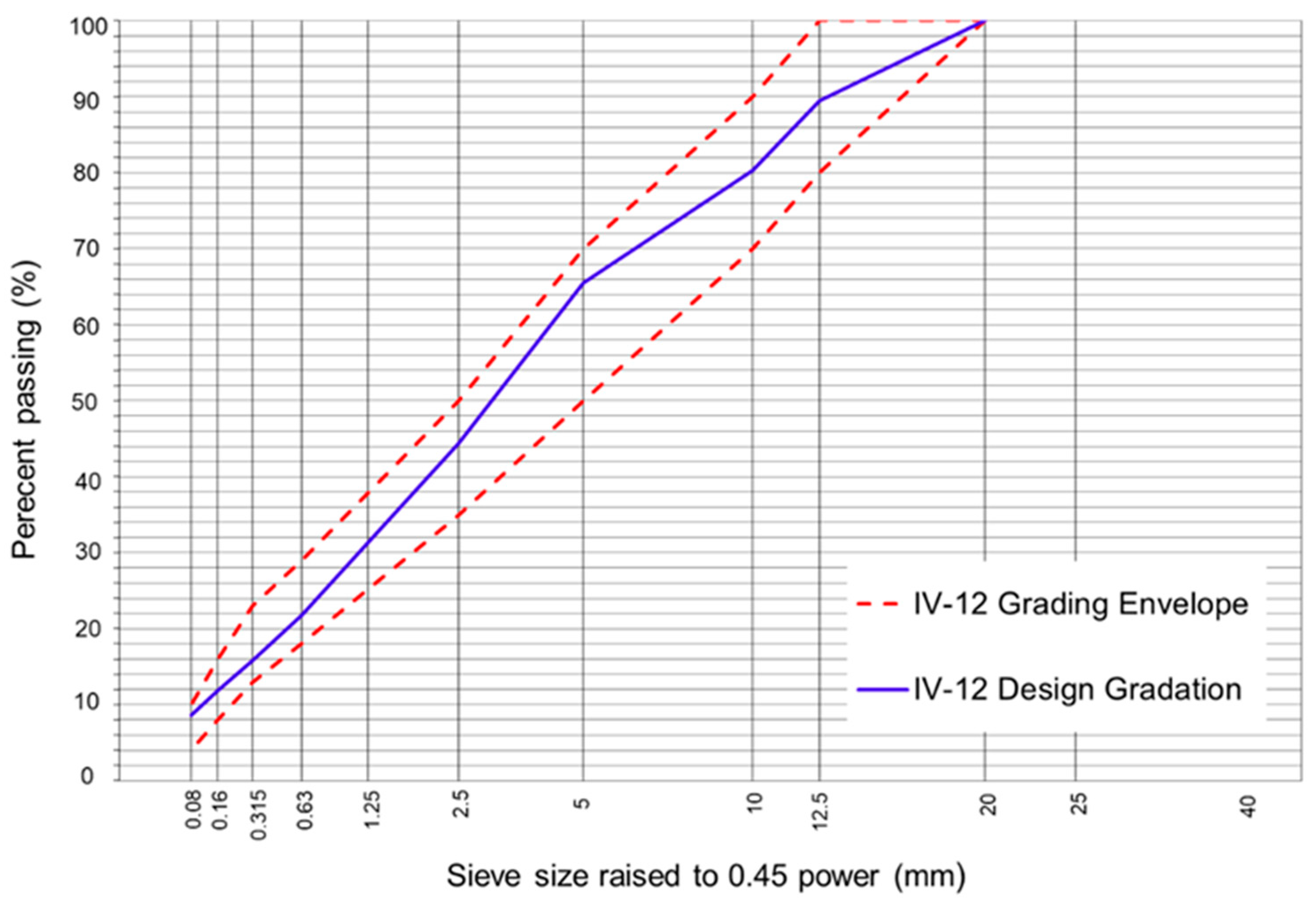
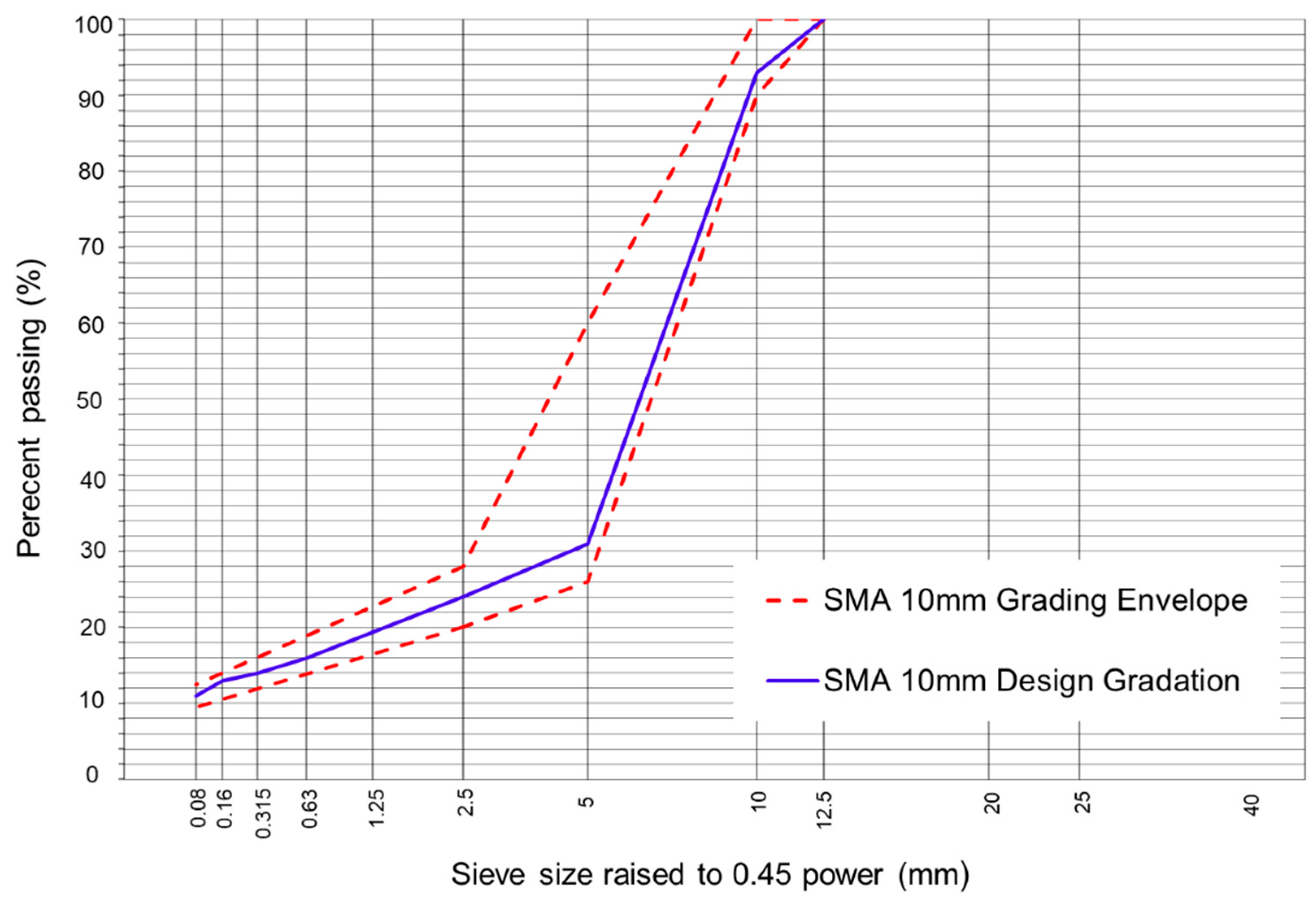



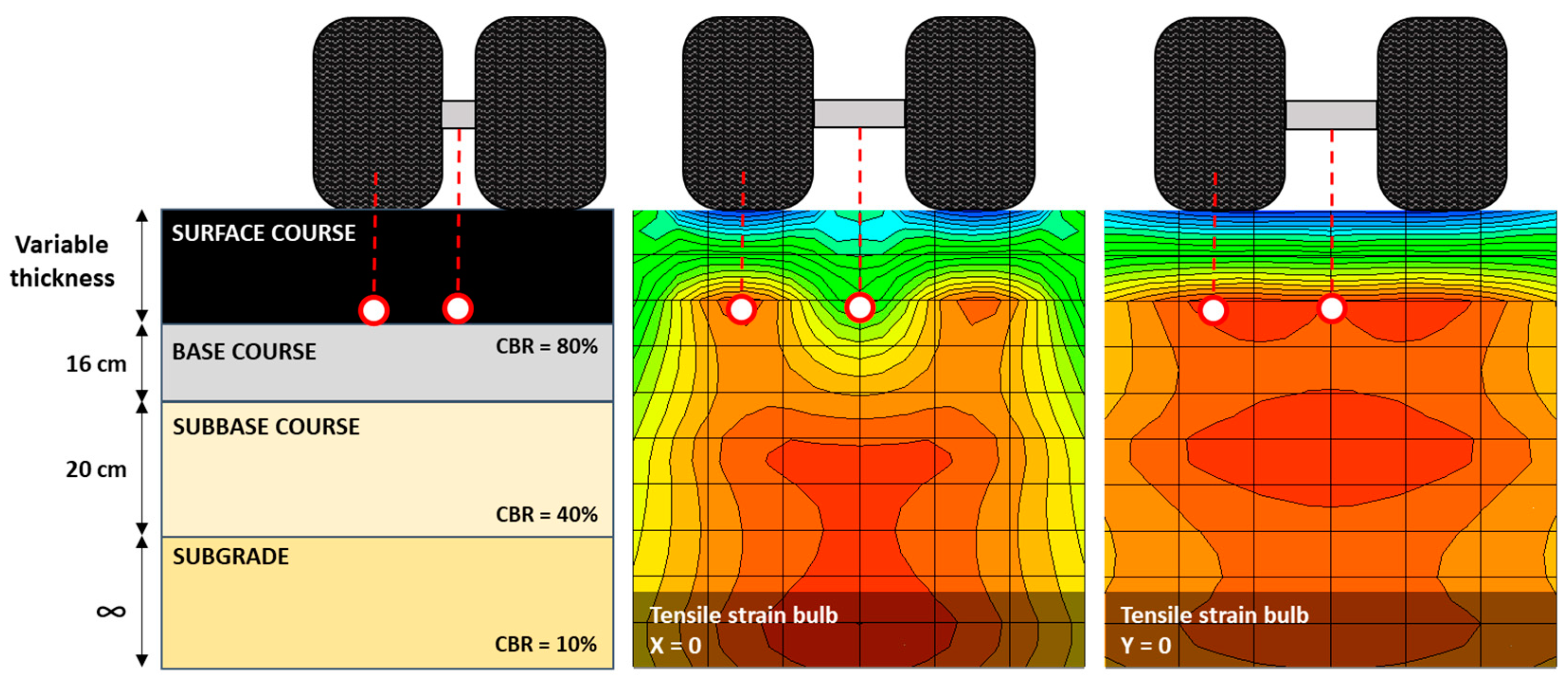
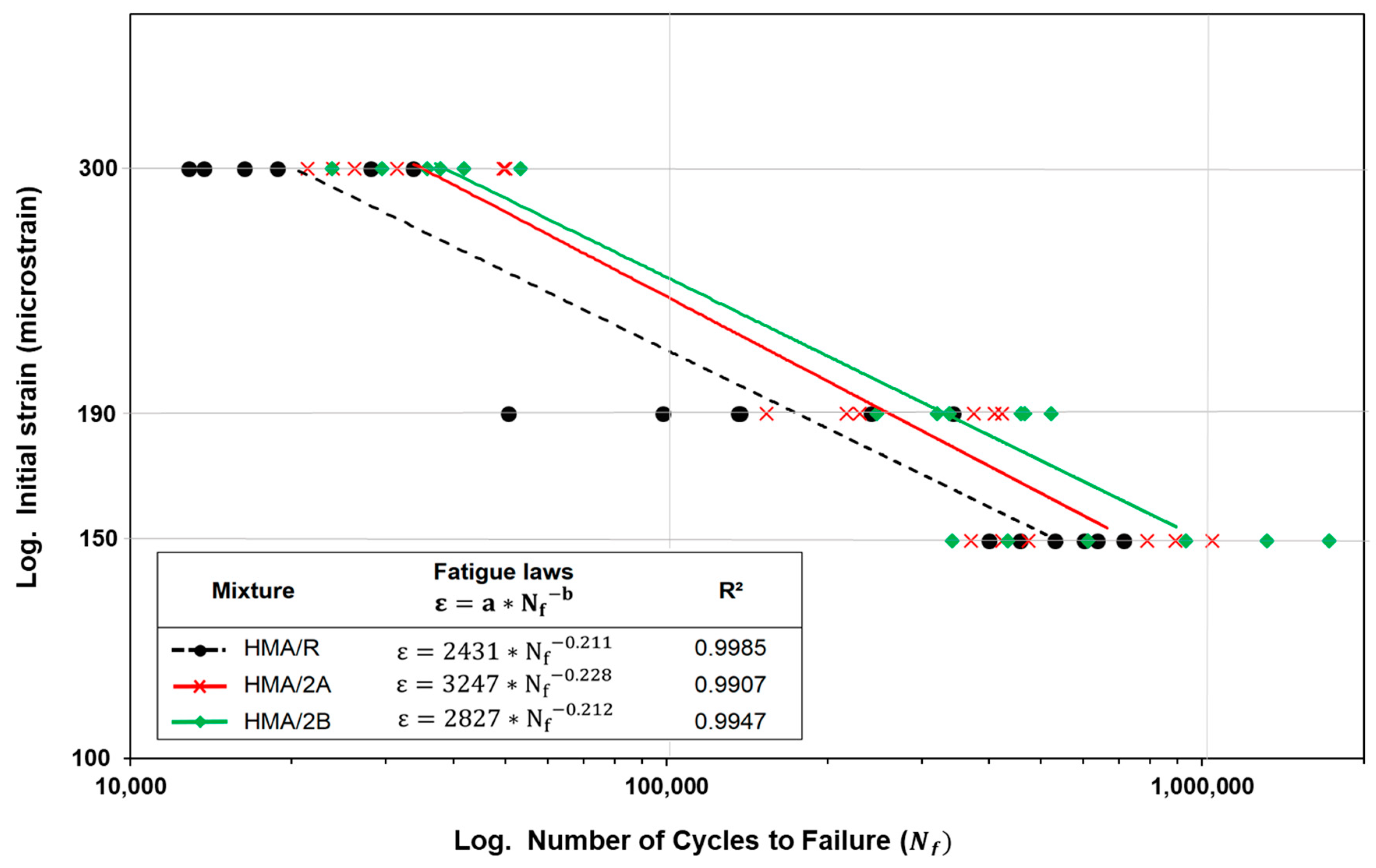
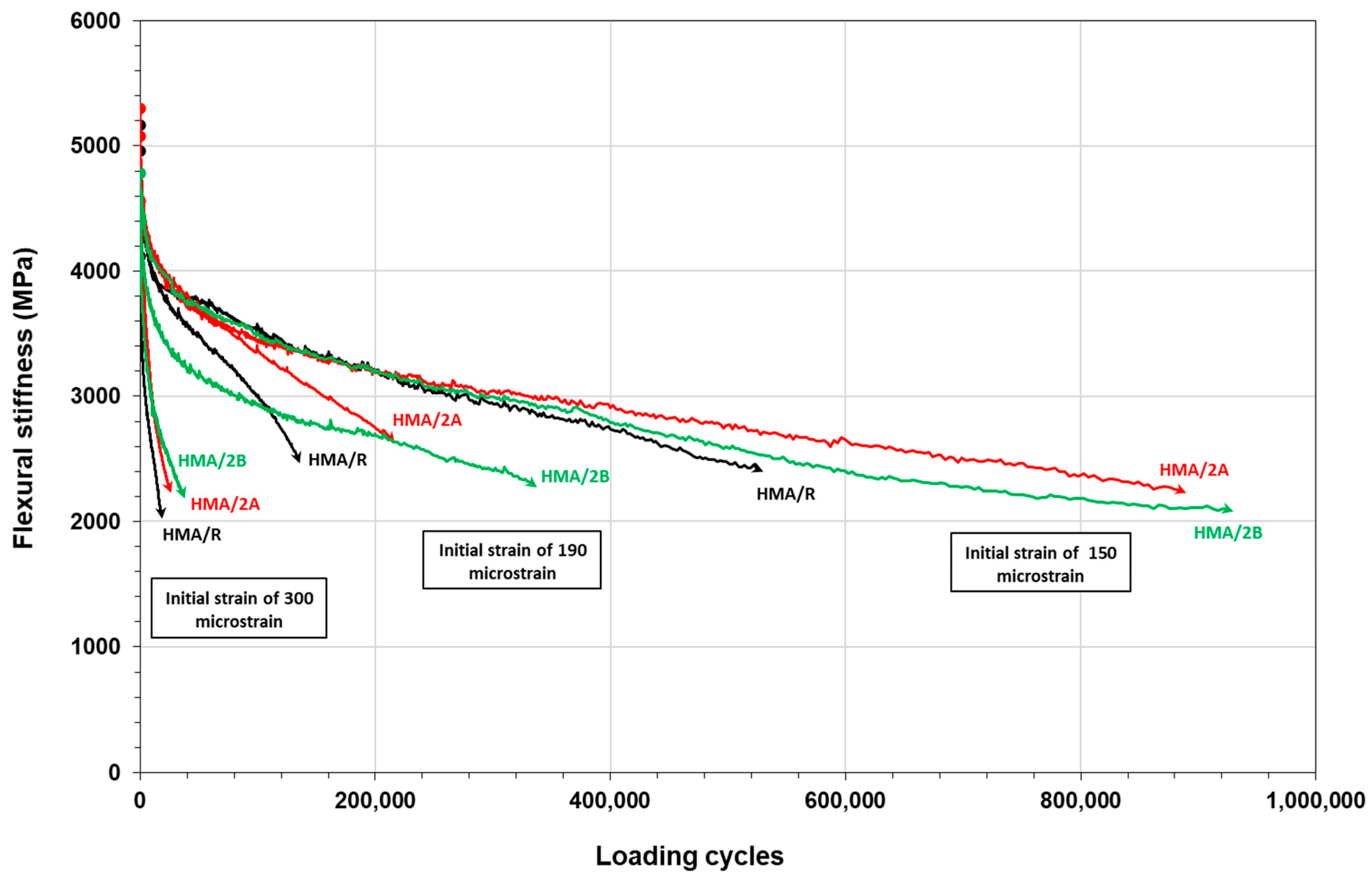
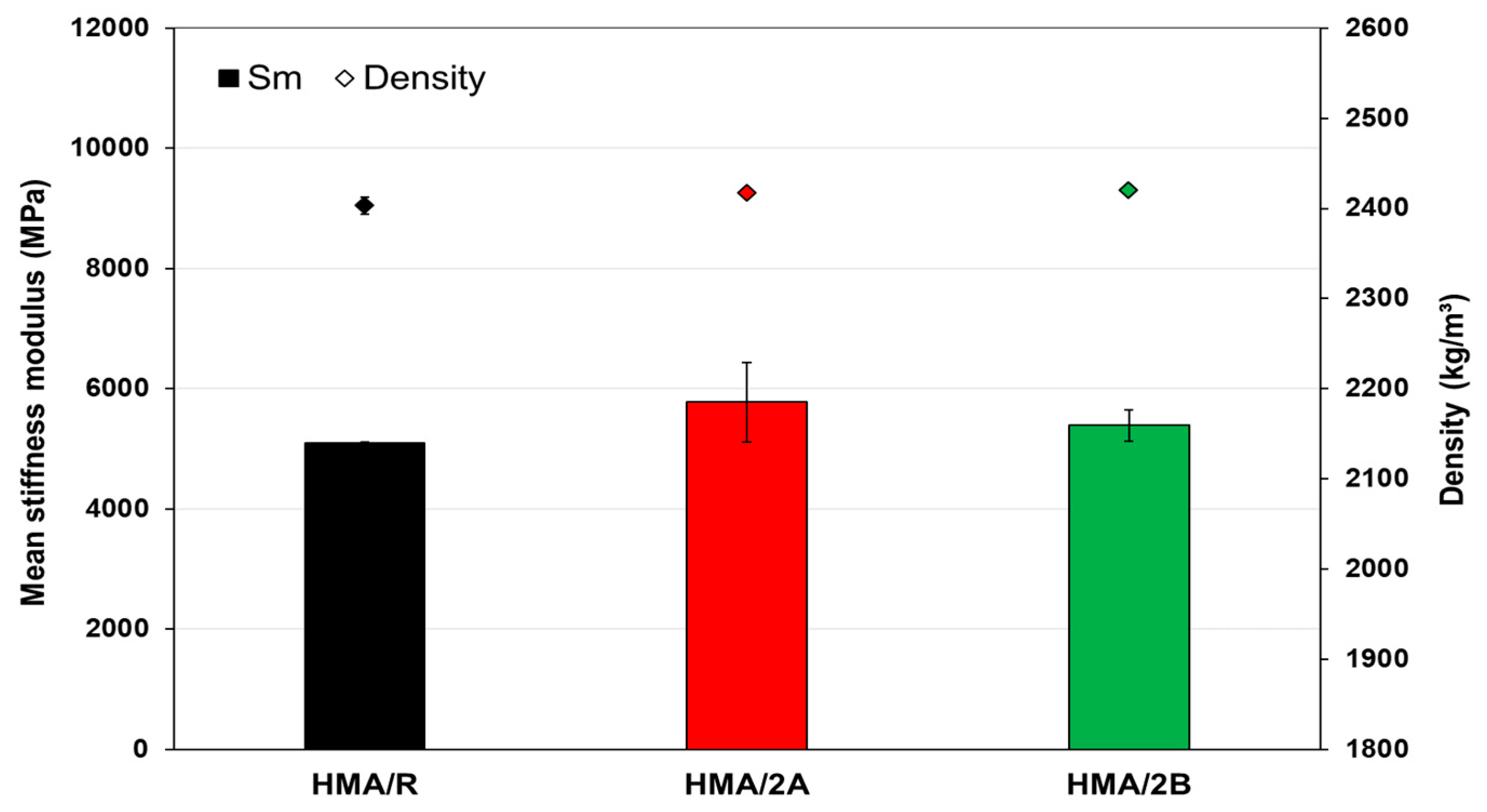
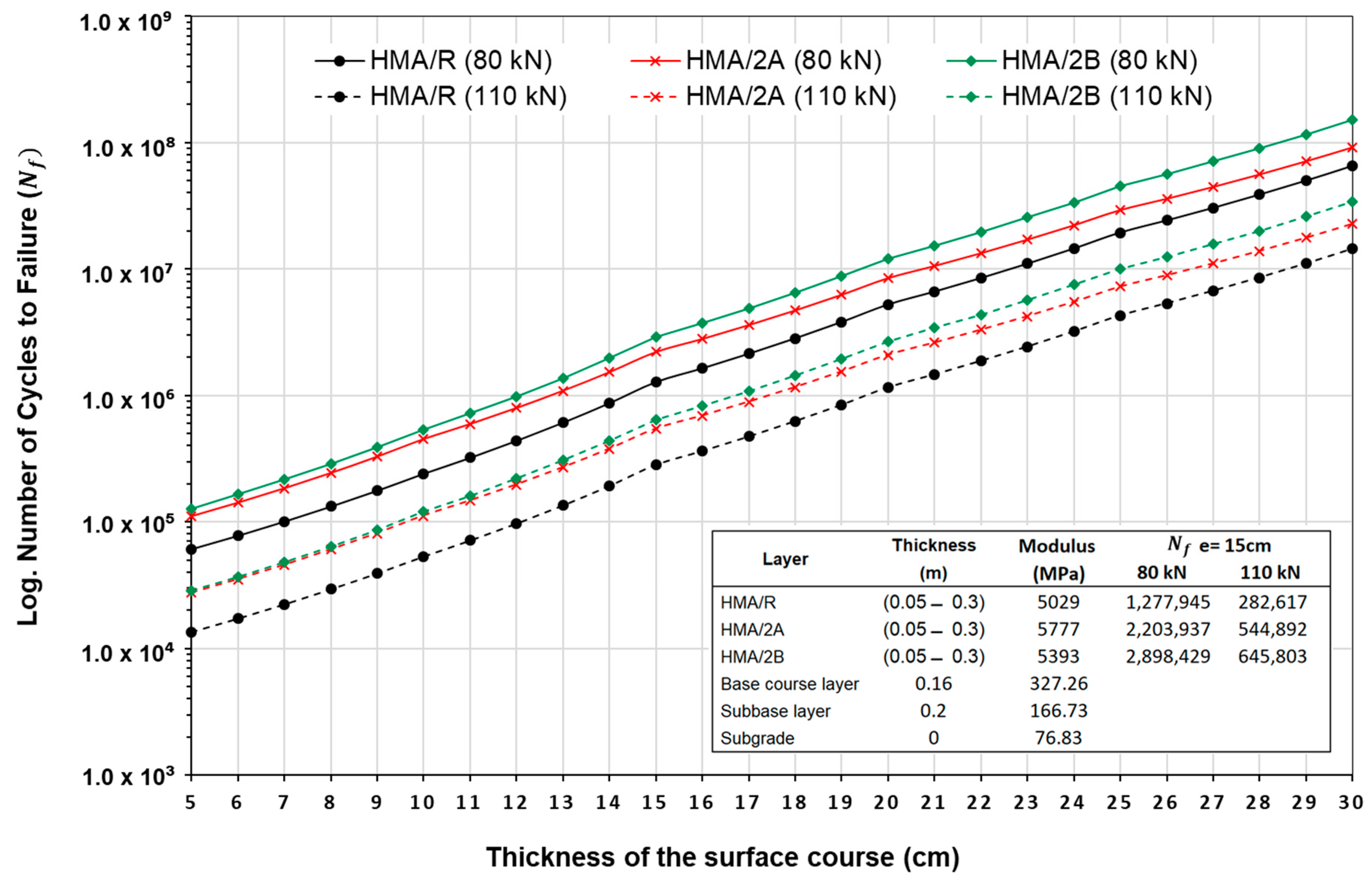

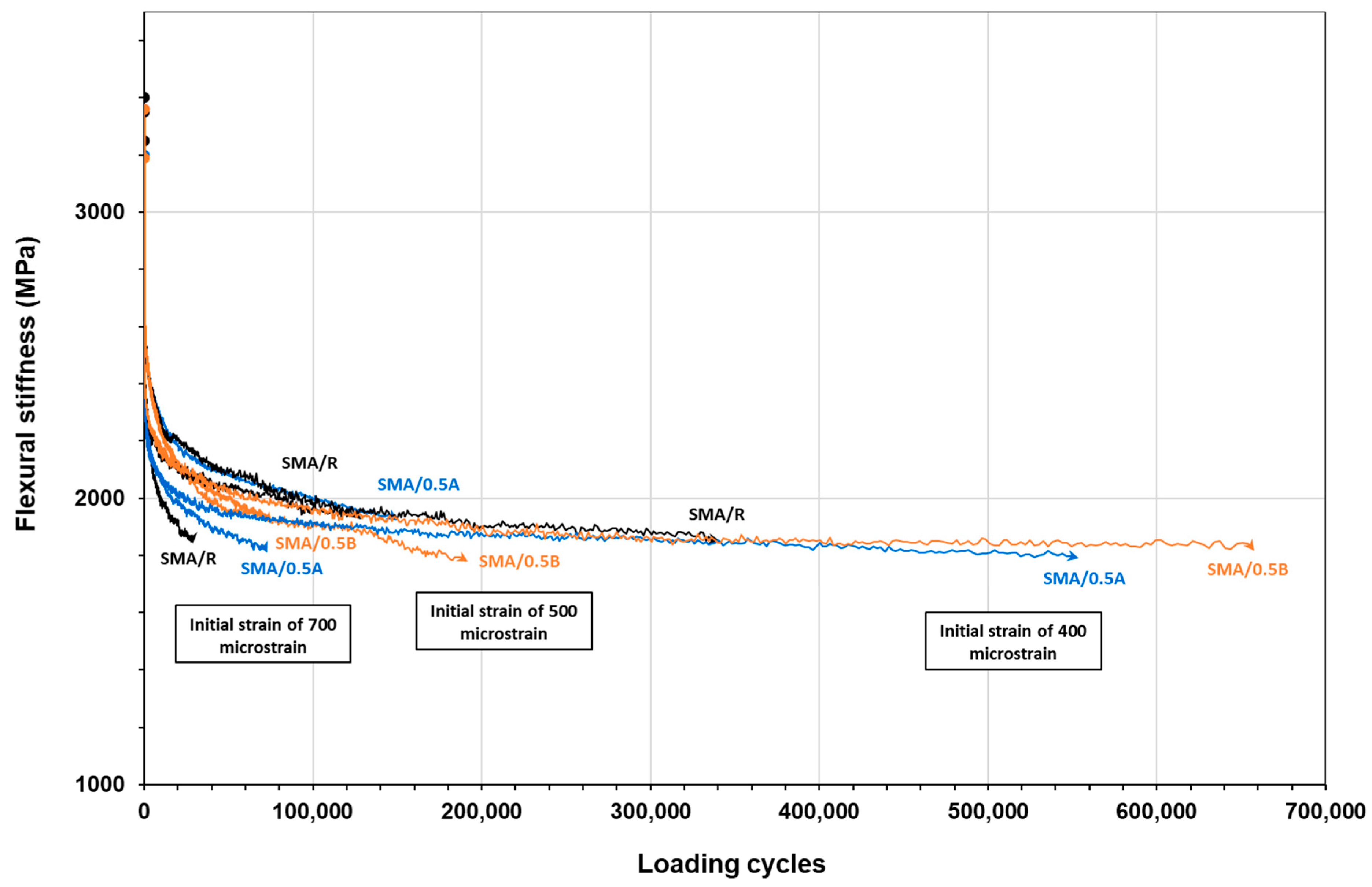

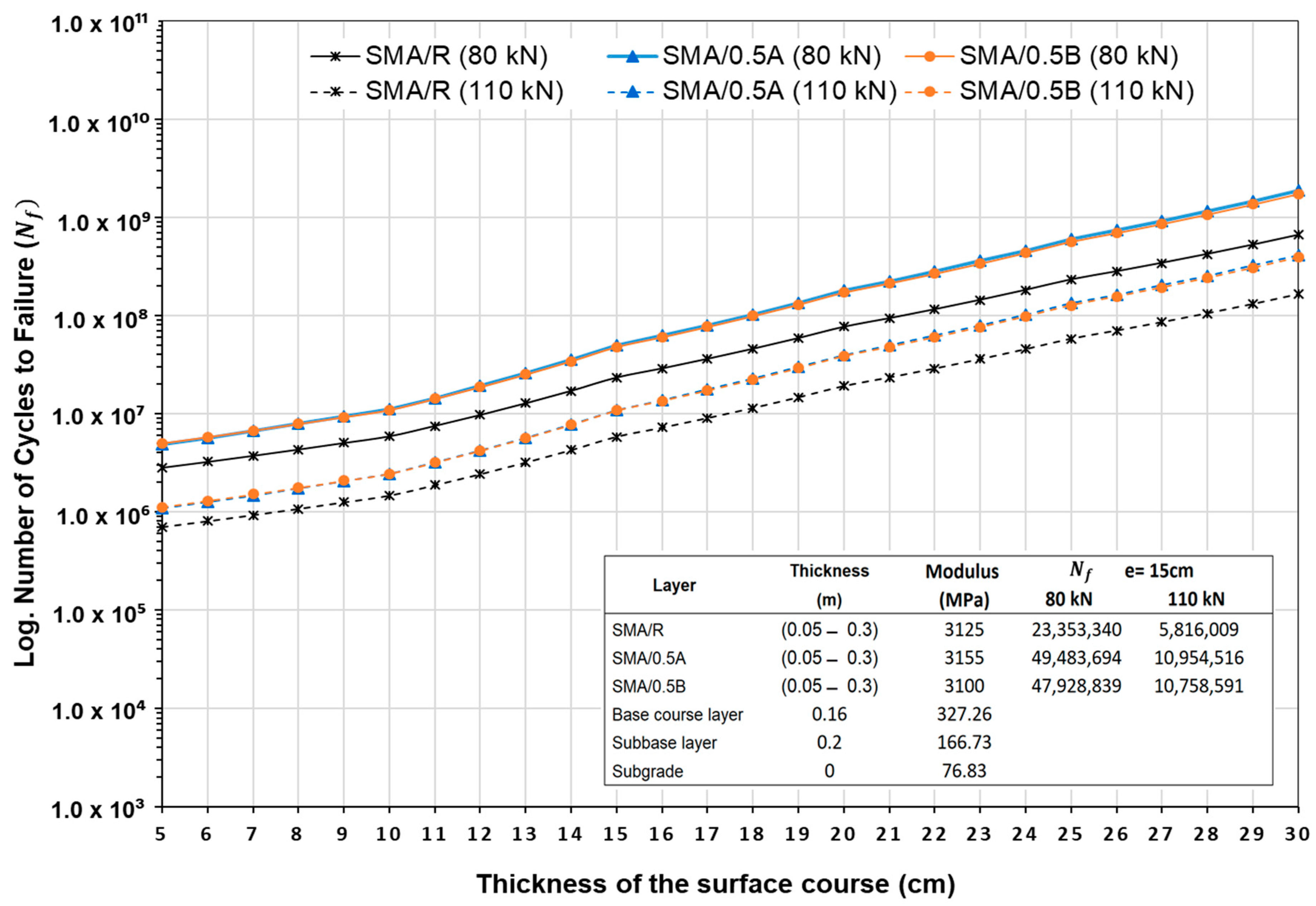
| Manual Manufacturing | Mechanical Manufacturing | ||
|---|---|---|---|
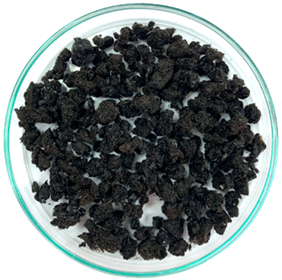 |  | ||
| Characteristic | Description | Characteristic | Description |
| Diameter range (mm) | 3.1–7.2 | Diameter range (mm) | 4.7–9.9 |
| Bulk density (g/cm³) | 0.15 | Bulk density (g/cm³) | 0.16 |
| Real density (g/cm³) | 1.15 | Real density (g/cm³) | 1.14 |
| Manual Manufacturing | Mechanical Manufacturing | ||
|---|---|---|---|
 |  | ||
| Characteristic | Description | Characteristic | Description |
| Diameter range (mm) | 3.6–5.8 | Diameter range (mm) | 4.9–6.8 |
| Length range (mm) | 4.8–12.1 | Length range (mm) | 6.3–14.2 |
| Bulk density (g/cm³) | 0.24 | Bulk density (g/cm³) | 0.19 |
| Real density (g/cm³) | 1.18 | Real density (g/cm³) | 1.14 |
 | |
| Characteristic | Description |
| Diameter range (mm) | 4.0–4.8 |
| Length range (mm) | 4.3–12.4 |
| Apparent density (gr/cm³) | 0.38 |
| Real density (gr/cm³) | 1.49 |
| Tests | CA-24 | Specs. [47] |
|---|---|---|
| Absolute viscosity at 60 °C, 300 mm Hg (P) | 3072 | Min. 2400 |
| Penetration at 25 °C, 100 g. 5 s. (0.1 mm) | 58 | Min. 40 |
| Ductility at 25 °C (cm) | >150 | Min. 100 |
| Spot test hep/xyl. (%xylene) | <30 | Max. 30 |
| Cleveland open cup flash point (°C) | 322 | Min. 232 |
| Softening point (Ring and Ball) (°C) | 51.4 | To be reported |
| Trichloroethylene solubility (%) | 99.9 | Min. 99 |
| Penetration index | −0.1 | −2.0 a + 1.0 |
| RTFOT (Rolling Thin-Film Oven Test) | ||
| Mass loss, (%) | 0.42 | Max. 0.8 |
| Absolute viscosity at 60 °C, 300 mm Hg (P) | 10,933 | To be reported |
| Ductility at 25 °C, 5 cm/min (cm) | >150 | Min. 100 |
| Durability index | 3.6 | Max. 4.0 |
| Mixing temperature at 2 Poise (°C) | 154 ± 5 | |
| Compaction temperature at 3 Poise (°C) | 145 ± 5 |
| Tests | CA 60/80 | Specs. [47] |
|---|---|---|
| Penetration at 25 °C, 100 g. 5 s. (0.1 mm) | 62 | 60–80 |
| Softening point (Ring and Ball) (°C) | 72.4 | Min. 60 |
| Ductility at 25 °C, 5 cm/min, (cm) | 112 | Min. 80 |
| Linear elastic recovery at 13 °C, 20 cm, 1 h (%) | 85 | Min. 50 |
| Elastic recovery by torsion at 25 °C (%) | 72 | Min. 60 |
| Penetration index | 3.8 | Min. +2.0 |
| FRAASS breaking point (°C) | −15 | Max. −15 |
| Flash point (°C) | >300 | Min. 235 |
| Storage stability | <4 | Max. 5.0 |
| Performance grade PG | 64V(22)-28 | To be reported |
| Mixing temperature at 2 Poise (°C) | 177 ± 5 | |
| Compaction temperature at 3 Poise (°C) | 165 ± 5 |
| Tests | HMA | SMA | Specs. [48] |
|---|---|---|---|
| Coarse aggregate | |||
| Los Angeles abrasion loss (%) | 20 | 14 | Max. 25 |
| Sodium sulfate soundness (%) | 2.4 | 0.3 | Max 12 |
| Crushed aggregates (%) | 96 | 96 | Min. 90 |
| Flaky aggregates (%) | 1 | 0.5 | Max. 10 |
| Static adhesion method | >95 | >95 | Min. 95 |
| Dynamic adhesion method | >95 | >95 | Min. 95 |
| Specific gravity (kg/m3) | 2685 | – | – |
| Absorption (%) | 1.54 | – | – |
| Fine aggregate | |||
| Plasticity index | Non-plastic | Non-plastic | Non-plastic |
| Riedel-Weber adhesion | 3–10 | 4–9 | Min. 0–5 |
| Sodium sulfate soundness (%) | 1.4 | 1.0 | Max. 15 |
| Specific gravity (kg/m3) | 2650 | – | – |
| Absorption (%) | 1.1 | – | <3 |
| Combined aggregate | |||
| Soluble salts (%) | 0 | 0 | Max. 2 |
| Sand equivalent (%) | 70 | 53 | Min. 50 |
| Water absorption (%) | – | 1.2 | Máx. 2 |
| Mix Type | Manufacturing Temperature | Total Bitumen Content | WTTF-Based Additive | WTTF-Based Additive | Commercial Cellulose Additive | Density | Stability | Flow | Air Voids | VMA | Binder Drainage | ||
|---|---|---|---|---|---|---|---|---|---|---|---|---|---|
| (°C) | (% by Weight of Aggregate) | (% by Weight of AB) | (% by Weight of Aggregate) | (kg/m³) | (N) | 0.25 mm | (%) | (%) | (%) | (%) | (%) | ||
| HOT-MIX ASPHALT | |||||||||||||
| HMA/R | 154 | 5.3 | 0 | - | - | 2418 | 13,745 | 10.8 | 3.1 | 13.9 | - | - | - |
| HMA/2A | 154 | 5.3 | 2 | - | - | 2408 | 13,471 | 10.9 | 3.4 | 14.2 | - | - | - |
| HMA/2B | 154 | 5.3 | 2 | - | - | 2420 | 15,953 | 10.7 | 3.0 | 13.8 | - | - | - |
| Chilean specifications for wearing course [47,50] | >9000 | 8–14 | 3–5 | >13 | |||||||||
| STONE MASTIC ASPHALT | |||||||||||||
| SMA/R | 177 | 6.8 | - | 0 | 0.5 | 2333 | 13,087 | 12.1 | 4.2 | 18.2 | 31.3 | 40.1 | 0.12 |
| SMA/0.5A | 177 | 6.8 | - | 0.5 | 0 | 2328 | 13,232 | 14.1 | 4.2 | 18.4 | 31.2 | 40.1 | 0.17 |
| SMA/0.5B | 177 | 6.8 | - | 0.5 | 0 | 2327 | 13,232 | 13.5 | 4.3 | 18.4 | 31.2 | 40.1 | 0.16 |
| Chilean specifications for wearing course [49] | 4 | >17 | < | Max 0.3 | |||||||||
| Mix Type | Initial Strain | Initial Phase Angle | Desv. | Final Phase Angle | Desv. | Dissipated Energy | Desv. |
|---|---|---|---|---|---|---|---|
| (Microstrain) | (δ) | (δ) | (J/m3) | ||||
| HMA/R | 300 | 38.0 | 1.5 | 43.8 | 1.9 | 11.1 | 5.5 |
| 190 | 34.8 | 1.4 | 40.9 | 0.9 | 37.4 | 13.5 | |
| 150 | 33.1 | 0.9 | 39.7 | 2.0 | 75.6 | 11.7 | |
| HMA/2A | 300 | 37.4 | 1.8 | 44.9 | 0.7 | 19.1 | 6.1 |
| 190 | 34.4 | 1.7 | 40.8 | 0.3 | 66.6 | 12.1 | |
| 150 | 32.9 | 1.7 | 39.6 | 2.4 | 95.7 | 19.2 | |
| HMA/2B | 300 | 37.3 | 1.7 | 45.7 | 1.6 | 20.2 | 4.6 |
| 190 | 35.8 | 2.5 | 43.2 | 1.2 | 82.3 | 17.9 | |
| 150 | 34.7 | 1.6 | 42.4 | 1.6 | 111.6 | 28.6 |
| Mix Type | Initial Strain | Initial Phase Angle | Desv. | Final Phase Angle | Desv. | Dissipated Energy | Desv. |
|---|---|---|---|---|---|---|---|
| (Microstrain) | (δ) | (δ) | (J/m³) | ||||
| SMA/R | 700 | 50.2 | 1.0 | 56.8 | 0.2 | 39.5 | 10.0 |
| 500 | 48.6 | 1.9 | 54.6 | 1.4 | 120.2 | 69.8 | |
| 400 | 47.1 | 0.9 | 49.6 | 2.9 | 170.1 | 153.9 | |
| SMA/0.5A | 700 | 49.7 | 2.0 | 56.7 | 0.9 | 51.6 | 18.5 |
| 500 | 46.6 | 0.7 | 54.7 | 0.4 | 82.8 | 33.0 | |
| 400 | 47.0 | 1.7 | 52.3 | 1.3 | 289.8 | 279.9 | |
| SMA/0.5B | 700 | 49.4 | 1.9 | 57.1 | 1.4 | 51.7 | 26.7 |
| 500 | 46.2 | 1.0 | 53.5 | 1.3 | 100.8 | 60.4 | |
| 400 | 48.0 | 1.1 | 52.5 | 1.6 | 218.5 | 108.1 |
| Source | Adjusted Sum of Squares | Adjusted Mean Square | F-Value | p-Value |
|---|---|---|---|---|
| Hot-mix asphalt | ||||
| Durability of asphalt mixtures | ||||
| Thickness (cm) | 4.23876 × 1016 | 1.69551 × 1015 | 8.69 | 0.000 |
| WTTF-based additive | 2.14583 × 1015 | 1.07292 × 1015 | 5.50 | 0.000 |
| Axle load | 7.28573 × 1015 | 7.28573 × 1015 | 37.33 | 0.005 |
| Stone mastic asphalt | ||||
| Durability of asphalt mixtures | ||||
| Thickness (cm) | 8.23432 × 1018 | 3.29373 × 1017 | 8.17 | 0.000 |
| WTTF-based additive | 5.08331 × 1017 | 2.54166 × 1017 | 6.31 | 0.002 |
| Axle load | 1.59942 × 1018 | 1.59942 × 1018 | 39.70 | 0.000 |
Disclaimer/Publisher’s Note: The statements, opinions and data contained in all publications are solely those of the individual author(s) and contributor(s) and not of MDPI and/or the editor(s). MDPI and/or the editor(s) disclaim responsibility for any injury to people or property resulting from any ideas, methods, instructions or products referred to in the content. |
© 2024 by the authors. Licensee MDPI, Basel, Switzerland. This article is an open access article distributed under the terms and conditions of the Creative Commons Attribution (CC BY) license (https://creativecommons.org/licenses/by/4.0/).
Share and Cite
Valdes-Vidal, G.; Calabi-Floody, A.; Mignolet-Garrido, C.; Bravo-Espinoza, C. Enhancing Fatigue Resistance in Asphalt Mixtures with a Novel Additive Derived from Recycled Polymeric Fibers from End-of-Life Tyres (ELTs). Polymers 2024, 16, 385. https://doi.org/10.3390/polym16030385
Valdes-Vidal G, Calabi-Floody A, Mignolet-Garrido C, Bravo-Espinoza C. Enhancing Fatigue Resistance in Asphalt Mixtures with a Novel Additive Derived from Recycled Polymeric Fibers from End-of-Life Tyres (ELTs). Polymers. 2024; 16(3):385. https://doi.org/10.3390/polym16030385
Chicago/Turabian StyleValdes-Vidal, Gonzalo, Alejandra Calabi-Floody, Cristian Mignolet-Garrido, and Cristobal Bravo-Espinoza. 2024. "Enhancing Fatigue Resistance in Asphalt Mixtures with a Novel Additive Derived from Recycled Polymeric Fibers from End-of-Life Tyres (ELTs)" Polymers 16, no. 3: 385. https://doi.org/10.3390/polym16030385






